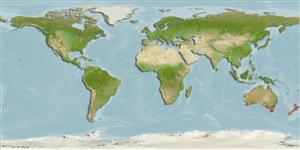>
Scombriformes (Mackerels) >
Arripidae (Australian salmon)
Etymology: Arripis: Latin, arripio, arripere = to take something suddenly.
More on author: Forster.
Environment: milieu / climate zone / depth range / distribution range
Ekologi
laut; payau; anadromus (ruaya dari laut ke air tawar) (Ref. 51243); kisaran kedalaman 30 - 39 m (Ref. 58489). Subtropical; 27°S - 47°S, 112°E - 176°W
Southwest Pacific: southern Australia (including Tasmania, Lord Howe Island and Norfolk Island), usually Brisbane to Western Victoria, rarely to Western Australia; and New Zealand (including Chatham and Kermadec Islands).
Length at first maturity / Size / Weight / umur
Maturity: Lm 32.5, range 29 - 36 cm
Max length : 89.0 cm TL jantan/; (Ref. 27296); common length : 47.0 cm TL jantan/; (Ref. 9258); Berat maksimum terpublikasi: 9.4 kg (Ref. 9988); Umur maksimum dilaporkan: 26 Tahun (Ref. 9072)
Duri punggung (Keseluruhan (total)): 9; duri punggung lunak (Keseluruhan (total)): 15-17; Duri dubur 3; Sirip dubur lunak: 9 - 10; vertebrata, bertulang belakang: 25. Adults are dark blue-green above and silvery below, with irregularly defined spots arranged laterally in indistinct rows (Ref. 33616). Length of upper lobe of caudal fin < 29.9% SL, more or less equal to, or less than, the length fo the head (Ref. 9701).
Inhabit continental shelf waters including estuaries, bays and inlets (Ref. 6390). Found between depths of 30 m (Ref. 33616) and 39 m (Ref. 58489). They enter rivers (Ref. 9002). Juveniles form school in shallow coastal bays and estuaries; adults move in large schools along shores (Ref. 9002), and can move over reefs in depths just sufficient to cover their bodies (Ref. 6390). They form large surface aggregations in deep water (Ref. 6390). Feed mainly on fishes but also on pelagic crustaceans, especially krill (Nyctiphanes australis). Take also food from the seabed. Fish smaller than 10 cm feed predominantly on copepods (Ref. 9072). Utilized fresh, canned and frozen; can be steamed, fried, broiled, boiled, microwaved and baked (Ref. 9988).
Eastern Australian salmon are probably serial batch spawners (Ref. 27961).
Paulin, C., 1993. Review of the Australian fish Family Arripididae (Percomorpha), with the description of a new species. Aust. J. Mar. Freshwat. Res. 44(3):459-471. (Ref. 9701)
Status IUCN Red List (Ref. 130435)
ancaman kepada manusia
Harmless
penggunaan manusia
Perikanan: komersial; Ikan buruan: ya; umpan: usually
informasi lanjut
mitraGambarStamps, Coins Misc.Suara-suaraCiguateraKecepatanTipe renangArea insangOtolithsOtakPenglihatan / visi
Alat, peralatan
laporan khas
muat turun XML
Sumber internet
Estimates based on models
Preferred temperature (Ref.
123201): 15.6 - 22.3, mean 17.4 °C (based on 14 cells).
Phylogenetic diversity index (Ref.
82804): PD
50 = 0.6250 [Uniqueness, from 0.5 = low to 2.0 = high].
Bayesian length-weight: a=0.00955 (0.00352 - 0.02589), b=3.01 (2.79 - 3.23), in cm total length, based on LWR estimates for this (Sub)family-body shape (Ref.
93245).
Trophic level (Ref.
69278): 4.1 ±0.6 se; based on diet studies.
Generation time: 4.1 (3.3 - 7.9) years. Estimated as median ln(3)/K based on 11
growth studies.
Daya lenting (Ref.
120179): sedang, Waktu penggandaan populasi minimum 1.4 - 4.4 tahun (K=0.2-0.3; tm=4).
Prior r = 0.47, 95% CL = 0.31 - 0.72, Based on 2 stock assessments.
Fishing Vulnerability (Ref.
59153): Moderate vulnerability (37 of 100).
Climate Vulnerability (Ref.
125649): Very high vulnerability (100 of 100).
Nutrients (Ref.
124155): Calcium = 52.1 [34.3, 88.4] mg/100g; Iron = 1.2 [0.8, 1.8] mg/100g; Protein = 20.7 [18.4, 22.6] %; Omega3 = 0.365 [0.227, 0.591] g/100g; Selenium = 19.2 [11.0, 32.9] μg/100g; VitaminA = 13.8 [5.4, 36.4] μg/100g; Zinc = 0.672 [0.506, 0.912] mg/100g (wet weight); based on
nutrient studies.
